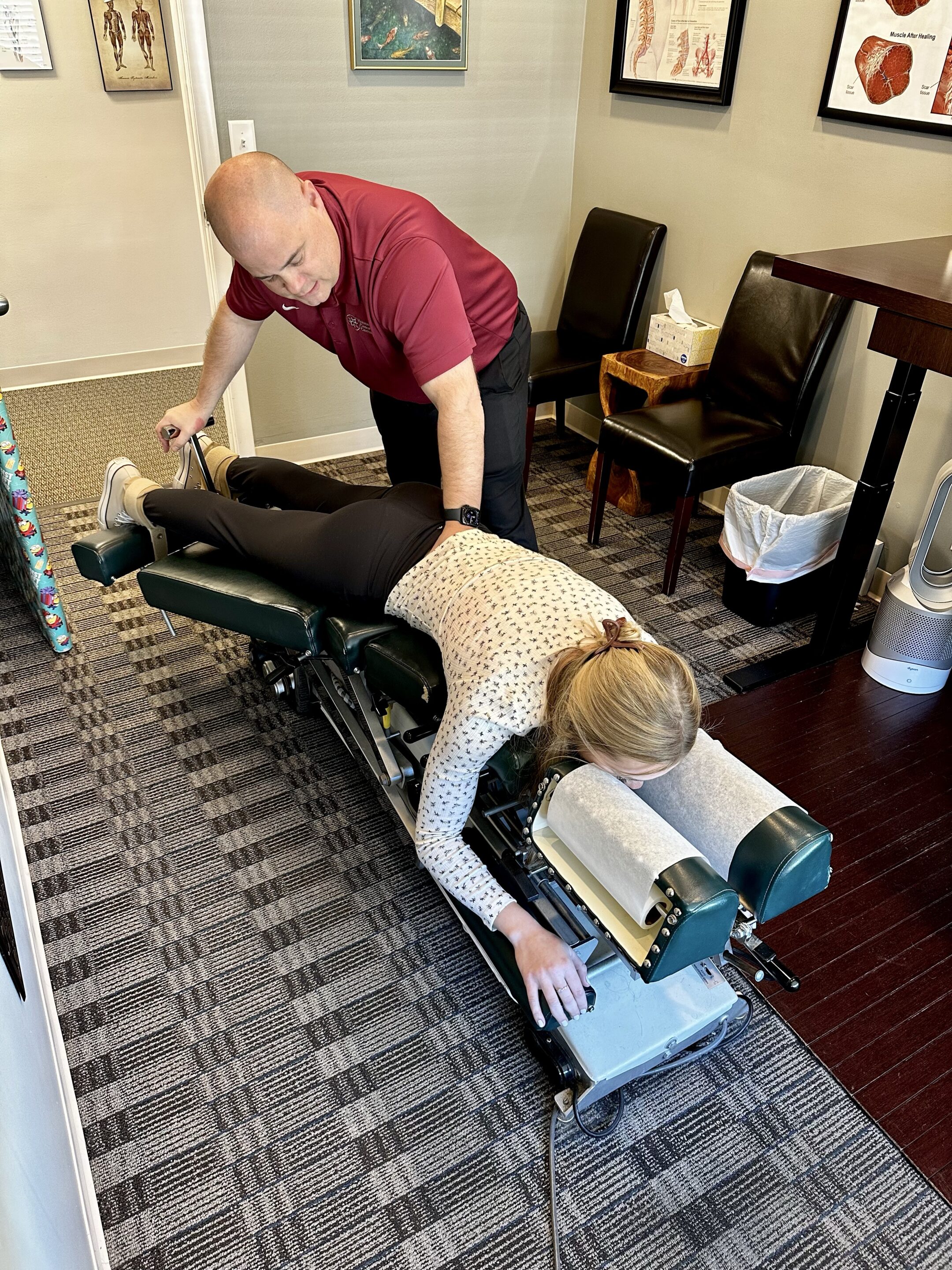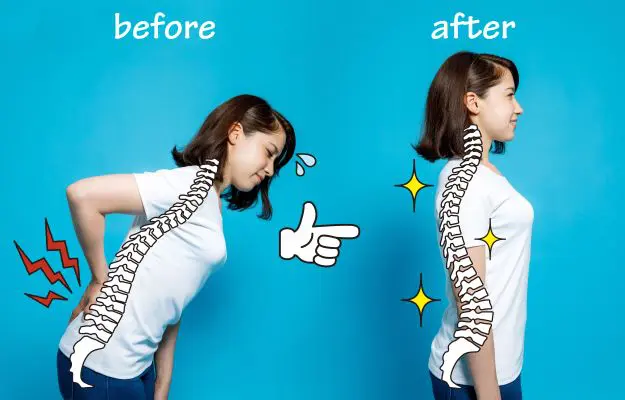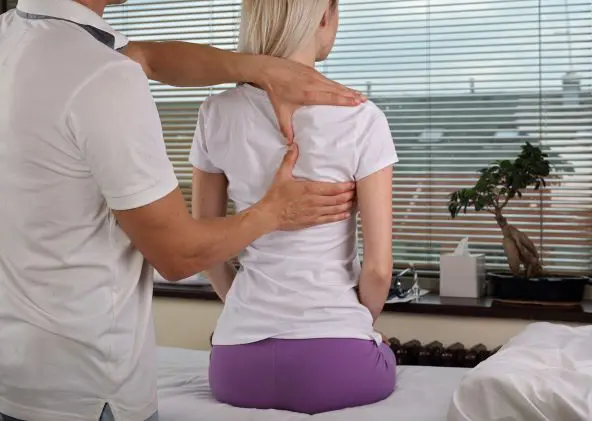Chiropractic Adjustment

What does a chiropractor do?
Chiropractors use chiropractic adjustments as one of the many tools to help to normalize the performance of the neuromusculoskeletal system. Chiropractic adjustments are simply inputting a force into a joint in order to help restore normal motion of that joint.
The idea that the spine was acutely connected to health is nothing new. In fact, the ancient Greeks and other early civilizations used spinal adjustments as a form of healthcare. Hippocrates, the Father of Western Medicine, stated that “physical structure is the basis of medicine” and went into great detail concerning the importance of the spine to good health. Hippocrates is quoted as saying: “Look well to the spine for the cause of disease.”

Why do joints need to be adjusted?
Chiropractic was initially founded on the idea that when bones were misaligned, they pushed on nerves and caused interference to the function of the nerves. So, if the nerve went to your stomach, a person could have indigestion because of the bone being misaligned. This explanation reflects the knowledge of anatomy and physiology of the late 1800s and early 1900s. At this time, it was thought that this alteration in nerve energy flow was the source of all diseases. Thankfully, we have progressed beyond this understanding and we now have more complete explanations of the processes that are going on in joints.
Sometimes, the wear and tear of everyday life can impact the spine and cause spinal segments to move in a way that is different to normal – in a dysfunctional way. That wear and tear can happen gradually, such as from bad posture, or it can happen suddenly, which is common with sports injuries.
As stated, there is typically something that is wrong with the function or the motion of the joint. All healthy joints exhibit normal active ranges of motion. You can passively stretch the joint a little bit further than what a person can actively do on their own without causing injury, which is called passive range-of-motion. Slightly beyond this passive stretching of the joint, there is a slightly additional movement of the joint called end-feel or joint play. Joint play is the passive movement in the joint at the end of passive physiological motion. Chiropractors learn how to gauge the end feel in most of the joints in the body.

Joints that are abnormal have an atypical end-feel or joint play. This feels like a decreased amount of bounce that you would normally get in the joint and is known as a restriction in the joint. It is also known as a blockage, fixation or somatic dysfunction, depending on the person assessing for it.
There are other methods of assessment such as the SFMA, which may indicate the need for chiropractic adjustments.
What Happens During a Chiropractic Adjustment?
On a typical visit, a patient may have other therapies first, like electric stim, massage therapy or therapeutic exercises or they may have their adjustment first. Some chiropractic offices have many patients that never get adjusted. When it is time for your chiropractic adjustment, the joints will be accesses for the need for an adjustment. Often, the doctor of chiropractic will perform similar adjustments on successive visits. Sometimes, a person may need a different treatment based on the daily history and examination and they will not have the regular adjustments performed. It depends on what is found during the assessment.
Chiropractic adjustments are most often done using the chiropractor’s hands. These chiropractic adjustments typically involve quick thrusts of movement that don’t move very far. The patient should try to be relaxed during the adjustment and the chiropractic physician should help you to relax.
The roots of the word “chiropractic” can be roughly translated into “to do by hand” because “chiro” means “hand” and “prattien” means “do” in Greek.
The chiropractic physician will make contact with involved area and will assess to see how much motion is present and whether it is normal. The doctor will help you to get into position for the adjustment and make sure that you are as relaxed as possible. In the case of manual adjustments, the chiropractor will apply a quick impulse into the joint that may or may not result in a noise, like a crack or a pop. This noise is called a joint cavitation and is an audible release in gas that can occurs when the joint releases pressure.
Sometimes, a patient cannot relax or there is too much muscle spasm or pain for an adjustment to be done by hand. There are many who prefer the Activator to manual adjusting as they do not like the noise or sensation. There are options available when the patient needs to be adjusted in a gentler fashion. Gentle adjustments can be done using instruments like an Activator device or by using a drop table (a section on the table that moves to assist with the adjustment). These techniques may also be used on older patients or patients that may have a hard time getting into position to do a manual adjustment. Adjustments done using drops or the Activator typically do not result in the cavitation noise. You should be sure to tell your chiropractor if you feel that you would prefer this low-force manipulation.

What Conditions do Chiropractors Treat?
Listed below is a host of conditions that chiropractors treat. Click here for a more comprehensive list of the conditions that we treat the Harmony Chiropractic Center, Inc.
Spinal Conditions
- Low Back Pain
- Upper Back Pain
- Neck Pain
- Arthritis
- Migraine Headaches
- Tension Headaches
- Cervicogenic Headache
- Other Types of Headaches
- Herniated Discs
- Pinched Nerves
- Sciatica
- Cervical or Lumbar Radiculopathy
- Facet Syndrome
- Sacroiliac Joint Dysfunction
- Whiplash
- Low back pain due to pregnancy
Upper Extremity Conditions
- Rotator Cuff Syndrome
- Medial Epicondylitis (Golfer’s Elbow)
- Lateral Epicondylitis (Tennis Elbow)
- Carpal Tunnel Syndrome
- Wrist Tendinitis
- Trigger Finger
Traumatic Conditions
- Repetitive Motion Injuries
- Spinal Disc Injuries
- Sports Injuries
- Strains & Sprains
- Traumatic Brain Injuries
- Whiplash
- Motor Vehicle Collisions
- Work-related Injuries
- Bruises
Lower Extremity Conditions
- Hip Pain
- Hip pain due to pregnancy
- Hamstring Injuries
- Patellofemoral Tracking Disorder
- Patellar Tendinitis (Knee Pain)
- Knee Pain
- Iliotibial Band Syndrome
- Shin Splints
- Tibialis Posterior Tendinitis
- Achilles Tendinitis (Heel Pain)
- Plantar Fasciitis (Heel Pain)
- Frequent ankle sprains
What Do Chiropractic Adjustments Feel Like?
Adjustments feel amazing, but everybody wants to know is whether or not chiropractic adjustment hurt. The answer is no, they should not hurt. It’s understandable that that is something that many people would be concerned about though. People see kung-fu movies and the like and think that it is an extremely dangerous activity, but it is not. Chiropractic care is extremely safe. It is true that people need to be relaxed during the actual adjustment. Typically, Dr. Royer will move you into the position where you will be adjusted and then check to see whether or not you have pain. If you can’t get in the position for an adjustment, it will not be forced because that is when an adjustment could hurt.

There are multiple methods that are available during chiropractic treatments so the method used can determine how the adjustment feels. In some cases, people will feel the quick impulse followed by a popping noise and release of pressure in the joints. It can also feel like stretching, rocking, applied pressure or light pushing. The Activator device makes it an extremely quick impulse and makes its own clicking noise as it’s used. The drop table makes noises it is lifted into place and as it drops down. The table will pop up underneath your hips, pelvis, abdomen or chest and drops quickly down when those areas are pushed on. There is also a special type of adjustment that uses a gentle stretching on the spine to separate spinal segments called Flexion Distraction Technique that feels like a deep pressure.
What to Expect After a Chiropractic Adjustment?
Reactions following a chiropractic adjustment will vary greatly between individuals. It can span from a great sense of exhilaration immediately after the adjustment, to a feeling of aching and soreness.
Patients often feel immediate changes after their adjustments. There is often an immediate relief from pain, like an immediate reduction in arm or leg pain. People also report having wider ranges of motion of the joints, improved concentration, stress relief and overall feelings of well-being. Many people report feeling taller or that a weight has been removed from their spine. Others have said that they see the world differently in that colors are brighter and more vivid. There are often times changes that happen that you don’t feel like improve sleep, lower levels of inflammation, having a stronger immune system and increased energy.

A common reaction to being adjusted initially is some aching or soreness in the area that was adjusted. Just like the delayed soreness that occurs after a new exercise, it usually only lasts a day or two.
What to Do After a Chiropractic Adjustment?

Occasionally after a chiropractic adjustment, a patient may get sore for a time. This is a normal side effect of a manipulation. Remember that the muscles around the joint are being stretched during the adjustment and they may act like those muscles are doing an exercise that they are not accustomed to. This soreness acts just like delayed onset muscle soreness (DOMS) and lasts at most a couple of days. The soreness does not usually last more than 24 hours. On the other hand, some people never get any soreness, so it is definitely based on the individual.
One of the things it’s often said is for people to drink more water just like you would after going to massage therapist. Unless you already drinking a gallon of water a day, this is going to be a good idea. A person might use heat or ice depending on the recommendation of the treating doctor and sometimes the doctor may recommend a topical analgesic like Bio Freeze.
If your doctor has given you any exercises or stretches to do, it would be wise to follow those recommendations. If you have any trouble doing your exercises or if you have any concerns, you should talk to your chiropractic physician. It is often a good idea to ask your chiropractor about other stretches or exercises before you try to do them at home. Often, people learn and attempt to perform exercises that are not appropriate for their situation.
People can also think about scheduling a massage if they have tight muscles. Massage therapy can be a wonderful addition to help care for people in pain.

I became Dr. Royer’s patient after running my first 5K. I had changed my lifestyle from a sedentary one to an active way of life. But after that first 5K, I developed hip and knee pain. Dr. Royer combined chiropractic adjustments with Kinesio Taping. I quickly saw positive results. The Kinesio Taping also allowed me to continue with my running and bicycling while my body healed. Dr. Royer also provided me with strengthening and range of motion exercises to further my healing process. I have since run 2 more 5K’s with no injury or pain. Dr. Royer also taught me about foods that were contributing to my symptoms and we have recently started treating an old surgery incision with the Graston Technique to break up the scar tissue. After only 2 treatments I am feeling results. My experience in Harmony Chiropractic Center has been a very positive one.
